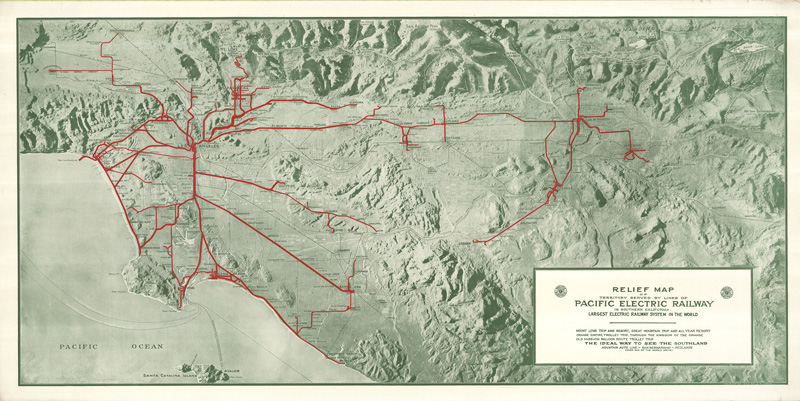Pacific Electric (PE) was America’s largest interurban electric railway system, blanketing the Los Angeles region with more than 1,000 miles of rail lines. The origins of the Red Car system date back to 1895 and the opening of the region’s first electric interurban line connecting Los Angeles with Pasadena. In 1901, real estate and utility tycoon Henry Huntington formed the Pacific Electric, sparking an intense period of interurban expansion and a battle with the Southern Pacific (SP) railroad for control of the region’s electric railways. Huntington sold his interests in the PE to the SP in 1910, and the Great Merger of 1911 consolidated almost all of the region’s interurbans under SP control. In exchange for his interest in the PE, Huntington gained complete control of Los Angeles’ local streetcar system, the Los Angeles Railway.
By 1914, more than 1,600 PE trains entered or left Los Angeles daily over the system’s four operating districts. The system reached its peak in the mid-Twenties; after that, it began a slow decline, halted temporarily by the traffic boom brought on by World War II, and then declining precipitously in the postwar years. In 1953, PE’s remaining passenger operations were sold to transit operator Metropolitan Coach Lines, who in turn sold the remaining lines to the Los Angeles Metropolitan Transit Authority in 1958. The last remnant of PE’s vast passenger operation, the line to Long Beach, was replaced with busses in 1961.
PE also operated a significant freight business, becoming the third largest originator of on-line freight in California. Many PE rail lines were retained for freight service after passenger operations ended, and several have even returned to transit use as modern light rail and commuter rail lines.
The Museum has a collection of over 35 pieces of rail equipment from the far-flung Red Car empire, including many of the most iconic pieces such as the classic Hollywood Cars of the 1920s and the enormous Blimps that closed out service on the PE in 1961.






